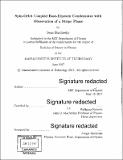| dc.contributor.advisor | Wolfgang Ketterle. | en_US |
| dc.contributor.author | Burchesky, Sean | en_US |
| dc.contributor.other | Massachusetts Institute of Technology. Department of Physics. | en_US |
| dc.date.accessioned | 2017-10-18T15:08:41Z | |
| dc.date.available | 2017-10-18T15:08:41Z | |
| dc.date.copyright | 2017 | en_US |
| dc.date.issued | 2017 | en_US |
| dc.identifier.uri | http://hdl.handle.net/1721.1/111888 | |
| dc.description | Thesis: S.B., Massachusetts Institute of Technology, Department of Physics, 2017. | en_US |
| dc.description | Cataloged from PDF version of thesis. | en_US |
| dc.description | Includes bibliographical references. | en_US |
| dc.description.abstract | In this work we build a new spin-orbit coupling experiment to observe the supersolidlike stripe phase. The phase diagram of a 1-dimensional spin-orbit coupled Bose- Einstein condensate shows several interesting phases including the stripe phase. We find the stripe phase particularly interesting because the condensate develops a density modulation in free space while remaining superfluid, which are the signature of supersolidity. In order to observe the stripe phase, we develop a novel spin-j basis which uses the orbital bands of an optical superlattice. Our choice of pseudo-spin basis allows the condensate components to remain miscible at high enough spin-orbit coupling strengths to observe the stripe phase. The superlattice constitutes a chain of spins which develop an antiferromagnetic spin texture and a density modulation at twice the lattice spacing. Breaking the discrete translational symmetry of the lattice while maintaining superfluidity indicates the formation of a lattice supersolid which we detected with Bragg scattering. Finally, the density modulation of the stripe phase is measured with a Bragg reflected beam and a camera setup to resolve the angular spread of the beam. An angle resolved, coherent Bragg beam is direct evidence of the stripe phase density modulation in free space. The formation of a free space density modulation in a superfluid Bose-Einstein condensate breaks the continuous spatial translation symmetry of space; fulfilling the definition of supersolidity. My primary contributions to the work include: controlling the superlattice, designing and building the Bragg detection scheme, some data collection and analysis. | en_US |
| dc.description.statementofresponsibility | by Sean Burchesky. | en_US |
| dc.format.extent | 129 pages in various pagings | en_US |
| dc.language.iso | eng | en_US |
| dc.publisher | Massachusetts Institute of Technology | en_US |
| dc.rights | MIT theses are protected by copyright. They may be viewed, downloaded, or printed from this source but further reproduction or distribution in any format is prohibited without written permission. | en_US |
| dc.rights.uri | http://dspace.mit.edu/handle/1721.1/7582 | en_US |
| dc.subject | Physics. | en_US |
| dc.title | Spin-orbit coupled Bose-Einstein condensates with observation of a stripe phase | en_US |
| dc.type | Thesis | en_US |
| dc.description.degree | S.B. | en_US |
| dc.contributor.department | Massachusetts Institute of Technology. Department of Physics | |
| dc.identifier.oclc | 1005078456 | en_US |
